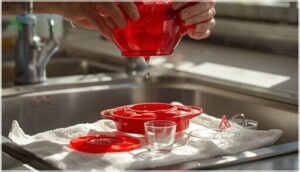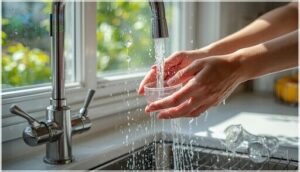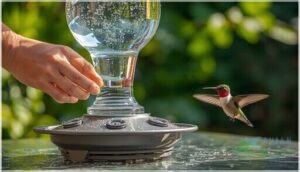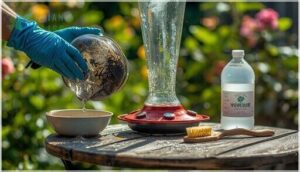This site is supported by our readers. We may earn a commission, at no cost to you, if you purchase through links.
A hummingbird feeder left uncleaned for just three days in warm weather can harbor dangerous mold and bacteria that sicken or kill the birds it’s meant to nourish. These tiny visitors possess rapid metabolisms that make them especially vulnerable to contaminated nectar—what seems like a minor oversight can have serious consequences.
The problem isn’t just spoiled sugar water; black mold colonizes feeding ports, yeast ferments in reservoirs, and harmful microbes multiply in conditions you can’t always see.
Regular, thorough cleaning protects hummingbirds from illness while ensuring they return to your yard throughout the season. The process requires specific tools, safe solutions, and attention to components that trap residue in hard-to-reach spaces.
Table Of Contents
- Key Takeaways
- What Supplies Do You Need to Clean a Hummingbird Feeder?
- Step-by-Step Guide to Cleaning a Hummingbird Feeder
- How Often Should You Clean a Hummingbird Feeder?
- Removing Mold and Tough Residue From Feeders
- Tips for Maintaining a Clean Hummingbird Feeder
- Frequently Asked Questions (FAQs)
- How to clean a hummingbird feeder?
- Does vinegar clean hummingbird feeders?
- How do you clean a bird feeder?
- How often should you clean a hummingbird feeder?
- How do you clean a hummingbird feeder?
- How to sterilize a hummingbird feeder?
- What is the best thing to clean hummingbird feeders with?
- Can I soak my hummingbird feeder in vinegar?
- How do I keep the bacteria out of my hummingbird feeder?
- Can I use a dishwasher to clean feeders?
- Conclusion
Key Takeaways
- Cleaning a hummingbird feeder every few days is essential, especially in hot weather, to prevent dangerous mold and bacterial growth.
- Use proper tools like bottle and port brushes along with safe cleaning solutions—such as diluted vinegar, hydrogen peroxide, or bleach—to scrub all parts, paying attention to hidden crevices.
- After disassembling and soaking, thoroughly rinse and air dry every feeder component before refilling with fresh nectar to keep birds safe.
- Placing feeders in the shade, rotating multiple feeders, and never using additives like honey or dyes helps maintain nectar freshness and protects hummingbird health.
What Supplies Do You Need to Clean a Hummingbird Feeder?
You don’t need a lot of fancy equipment to keep your hummingbird feeder clean and safe for visiting birds. A few basic tools and the right cleaning solutions will handle most maintenance tasks without much fuss.
Here’s what you should have on hand before you start.
Essential Cleaning Tools and Brushes
You’ll need the right brushes to reach every corner of your feeder. A bottle brush addresses the reservoir, while port brushes—ranging from 3/32″ to 1/4″ in diameter—clean tiny feeding holes where mold hides. Look for rust-resistant brushes with soft bristles that won’t scratch.
A bent brush or even a toothbrush helps with tricky angles, and cleaning kits often bundle everything together. For a complete solution, consider a dual-action brush kit designed for this purpose.
Safe Cleaning Solutions (Vinegar, Bleach, Peroxide)
Once you have your brushes, you’ll want safe cleaning solutions that kill mold without harming birds. White vinegar works at a 2:1 water-to-vinegar dilution, soaking feeders for 30 minutes to 2 hours. Peroxide offers safety with 3% concentration, effective in 15 minutes. Bleach alternatives exist, but 10% bleach solutions sterilize tough contamination—just rinse thoroughly.
Solution effectiveness depends on proper residue prevention through multiple water flushes. Hummingbirds need regular cleaning to stay healthy.
Protective Gear for Safe Handling
After selecting your cleaning solution, you’ll want to wear rubber gloves to protect against microbes and harsh chemicals. Nitrile gloves are a good choice as they resist bleach and vinegar while avoiding latex allergies. It’s also important to work in well-ventilated spaces or wear a mask when handling strong disinfectant fumes. If you’re scrubbing vigorously, consider wearing eye protection to prevent splashes.
| Glove Material Options | Best Use |
|---|---|
| Nitrile | Chemical resistance, hypoallergenic |
| Heavy-duty rubber | Frequent, prolonged cleaning |
| Disposable vinyl | Light, quick tasks |
These safe cleaning practices help prevent disease transmission to both you and visiting hummingbirds.
Step-by-Step Guide to Cleaning a Hummingbird Feeder
Cleaning your hummingbird feeder doesn’t have to be complicated, but it does require a consistent approach to protect the birds’ health.
The process involves five key steps, from taking the feeder apart to putting it back together with fresh nectar. Each step plays a specific role in removing contaminants and preventing the spread of disease.
Emptying and Disassembling The Feeder
Start by emptying the feeder completely—don’t reuse old nectar, as bacteria and mold can lurk inside. Pour it down the sink for proper disposal.
Next, carefully disassemble all feeder parts, including the reservoir, base, and feeding ports. This component separation lets you reach tight crevices where residue hides. Handle glass and plastic pieces gently to avoid breakage during disassembling.
Soaking Parts in Cleaning Solution
After you’ve disassembled the feeder parts, soaking them in a proper cleaning solution breaks down stubborn residue and kills harmful pathogens. Choose a method that fits your feeder’s material compatibility and the level of cleaning needed:
- Bleach solution (1 part bleach to 9 parts water) – soak for 10 to 15 minutes for effective disinfection
- Vinegar mixture (2 parts vinegar to 1 part water) – soak 30 minutes to 1 hour for natural cleaning
- Hydrogen peroxide – soak at least 15 minutes, safer for plastic components
- Warm soapy water – soak 15 minutes for routine maintenance
Solution effectiveness depends on soaking duration and safe concentrations. Always rinse thoroughly afterward to remove chemical residues before refilling.
Scrubbing Reservoirs, Ports, and Hard-to-Reach Areas
After soaking softens residue, you’ll need the right brush types to finish the job. Use a bottle brush with curved bristles—some reach 16 inches deep—to scrub reservoirs thoroughly.
For cleaning feeding ports and narrow tubes, switch to a drinking straw brush or soft-bristle port brush sized between 3/32″–1/4″ diameter. Port disassembly exposes hidden crevices.
Add rice as an abrasive cleaning agent with soap, then shake vigorously for safe practices that protect feeder surfaces.
Rinsing and Air Drying All Components
With feeder components in hand, rinse every part under running water—thoroughly. For stubborn residue, try a vinegar rinse. Air drying feeder parts fully is the key Rinsing Technique and Mold Prevention measure in safe cleaning feeder components. Place each item on a clean drying rack to air dry; don’t rush this step. Allow 4–6 hours, longer in humid weather.
Reassembling and Refilling The Feeder
Would you trust a leaky bottle for your own drink? Precise component alignment and secure assembly make all the difference—especially when serving hummingbird food. Once each feeder part is bone dry, reassemble tightly. Add fresh nectar solutions (four parts water, one part sugar). Mind refill timing and hygiene protocols, then position the reservoir snugly. Every detail safeguards both birds and nectar.
| Step | What to Check | Why It Matters |
|---|---|---|
| Align components | Ports/base fit snugly | Prevents leaks/spoilage |
| Tighten base | No wobbling/twist clicks | Keeps pests out/nectar in |
| Fill with nectar | Fresh sugar water only | Sustains bird health |
| Check refill timing | Schedule matches weather | Stops fermentation |
| Sanitize hands | Clean, gloved if needed | Ensures hygiene protocols |
How Often Should You Clean a Hummingbird Feeder?
How often you clean your hummingbird feeder depends on weather, nectar, and daily use. It’s not always easy to spot trouble just by looking. Here’s what you should keep in mind before setting your routine.
Cleaning Frequency by Temperature and Season
Temperature governs your cleaning schedule more than any other factor. In hot weather above 80°F, you’ll need to clean feeders daily as nectar spoils rapidly and bacteria multiply. When temperatures stay between 71-75°F, cleaning every six days works well. Cooler conditions allow you to extend cleaning intervals to four or five days.
Sunlight exposure accelerates spoilage, so shaded feeders require less frequent attention than those in direct sun.
Signs Your Feeder Needs Cleaning
You’ll notice cloudy nectar first, signaling bacterial growth and fermentation within days of spoilage. Mold growth appears as black spots around ports and above the nectar line, threatening hummingbird health. Slime buildup creates sticky films inside, while nectar discoloration turns the liquid murky or greenish.
Increased insect activity and reduced bird visits also warn you it’s time for preventing contamination through immediate cleaning.
Best Practices for Regular Maintenance
Once you spot warning signs, act quickly. Immediate cleaning protects hummingbird health and prevents mold growth. Establish a consistent hummingbird feeder maintenance routine using proper cleaning solutions and cleaning frequency guidelines:
- Replace nectar every 3-5 days to maintain freshness
- Use shaded placement to slow bacterial growth
- Rotate multiple feeders while one dries completely
- Air drying prevents contamination before refilling
Removing Mold and Tough Residue From Feeders
Black mold and sticky residue don’t just look bad—they can make hummingbirds sick. When regular rinsing isn’t enough, you’ll need stronger cleaning methods to restore your feeder. The right approach depends on what you’re dealing with and how stubborn the buildup has become.
Identifying Mold and Residue Buildup
Check your feeder regularly for dark spots or black film on ports and reservoirs—these are classic signs of mold. You’ll also notice cloudy or milky nectar, sticky residue, and fuzzy patches on inner surfaces.
These indicators appear when sugar residue accumulates in warm, humid conditions. Identifying mold early helps you act quickly, preventing mold growth and protecting the hummingbirds visiting your yard.
Using Bleach, Vinegar, or Peroxide Solutions
Once you’ve spotted mold, you’ll need the right cleaning solutions for feeders. Bleach offers the strongest disinfection—mix 1 part bleach with 9 parts water for safe cleaning of hummingbird feeders, soaking for 10–15 minutes.
White vinegar provides moderate efficacy at 70–80% germ removal, while peroxide benefits include odorless residue removal.
Each method requires thorough rinsing for bleach safety and complete residue removal, protecting visiting hummingbirds.
Cleaning With Rice or Specialty Brushes
Beyond soaking, you’ll need mechanical action for stubborn mold. Rice abrasiveness works wonders—add a tablespoon of uncooked rice with soapy water and shake vigorously for 20 minutes.
For feeding ports, specialized brush materials like dual-head brushes or microbrushes reach tight spots where mold hides. A pipe cleaner addresses narrow tubes effectively.
This combination ensures thorough residue removal while maintaining safe cleaning practices for your hummingbirds.
Ensuring Complete Removal and Safety
After removing mold from feeders, rinsing thoroughly until no cleaning solution odor remains protects hummingbirds from toxic residue. Air drying all feeder parts prevents moisture that encourages regrowth.
Feeder inspection for cracks or damage matters since these harbor bacteria. Rotating feeders allows proper cleaning cycles between uses.
Follow manufacturer instructions alongside these safe cleaning methods for complete removal and thorough care when cleaning hummingbird feeders.
Tips for Maintaining a Clean Hummingbird Feeder
Keeping your feeder clean doesn’t stop once you’ve scrubbed away the mold. Regular maintenance requires a few simple habits that prevent contamination before it starts.
Here are practical strategies to keep your hummingbirds healthy and your feeder in top condition.
Preventing Nectar Spoilage and Contamination
Fresh nectar won’t last forever, especially in warm weather. You need to replace it every one to two days during hot spells to prevent fermentation and bacteria buildup.
Safe nectar uses a simple four-to-one water-sugar ratio, no dyes or honey. Shaded placement slows spoilage considerably.
Visual indicators like cloudiness or off odors signal contamination. Regular changes and proper cleaning solutions maintain feeder hygiene effectively.
Using Multiple Feeders and Rotating Them
Rotating multiple feeders in your yard keeps at least one always available while you clean the others. This strategy ensures continuous access and reduces territorial battles at feeding sites. Hummingbirds naturally compete for nectar, but spreading feeders 10 to 25 feet apart lowers aggression by over 40% while boosting visits and supporting healthier populations.
Rotation benefits you’ll notice right away:
- Reduce aggression among territorial birds by providing separate feeding zones they can claim without constant conflict
- Increase visitation rates markedly, with multi-feeder setups attracting up to 28% more hummingbirds than single stations
- Boost nectar consumption per bird by minimizing stress and wait times at crowded ports
- Simplify your hummingbird feeder maintenance since the cleaning process never interrupts access to fresh food
- Create positive ecological effects by supporting diverse species assemblages and stable local populations year-round
Safe Nectar Recipes and Feeding Practices
Your homemade hummingbird nectar recipe must balance simplicity with hummingbird health. Mix one part white granulated sugar with four parts water—this 20% solution mirrors natural nectar concentrations hummingbirds prefer.
Avoid risky additives like honey, red dye, or artificial sweeteners, which introduce fungal risks and iron toxicity. Use tap or filtered water for best practices.
Change sugar water every one to two days in hot weather to prevent nectar spoilage and bacterial contamination threatening safe sweeteners’ effectiveness.
Placing Feeders for Reduced Mold Growth
Shade benefits your feeder by slowing nectar fermentation—shaded feeders develop mold 40% slower than sun-exposed ones.
Distance matters too: place feeders 10–15 feet from shrubs for airflow while avoiding dense foliage that traps humidity. Height advantages include better circulation when mounted 5–6 feet up. Feeder spacing of 10–20 feet reduces contamination by 30%.
Seasonal placement in cooler microclimates during humid weather extends freshness and lowers cleaning frequency guidelines from twice weekly to once.
Frequently Asked Questions (FAQs)
How to clean a hummingbird feeder?
You’ll want to disassemble the feeder completely, then soak all parts in a vinegar or diluted bleach solution.
Scrub reservoirs and ports thoroughly with specialized brushes, rinse well, and air dry before refilling.
Does vinegar clean hummingbird feeders?
Yes, vinegar solution effectively cleans hummingbird feeders and kills black mold. Mix two parts water with one part distilled white vinegar, soak feeder parts, scrub thoroughly, then rinse multiple times to remove all residue before refilling.
How do you clean a bird feeder?
Think of bird feeder cleaning as a reset button for your yard visitors.
You’ll empty, disassemble, and soak all parts in a mild soap or vinegar solution, scrub thoroughly, rinse completely, then air dry before refilling.
How often should you clean a hummingbird feeder?
Weather impacts determine feeder cleaning frequency: above 85°F, clean every 2–3 days; in cooler months, weekly suffices.
During migration seasons, increase cleaning hummingbird feeder routines to avoid nectar spoilage and protect bird health—watch for cleaning indicators.
How do you clean a hummingbird feeder?
Did you know up to half of backyard feeders show mold in summer?
Use safe cleaning solutions, follow proper disassembly techniques, rinse thoroughly, air dry, and reassemble. Reliable feeder cleaning instructions and drying methods help keep hummingbirds safe.
How to sterilize a hummingbird feeder?
Sterilization starts by soaking feeder parts in a cleaning solution, such as a vinegar or hydrogen peroxide mix, or a bleach solution for deeper mold removal.
Increase cleaning frequency in warm weather for safe maintenance and effective hummingbird feeder cleaning.
What is the best thing to clean hummingbird feeders with?
For a truly clean hummingbird feeder, white vinegar or hydrogen peroxide work well for most cleaning, while a 10% bleach solution tackles tough mold.
Always skip dish soap, rinse thoroughly, and remember—safe cleaning tips keep birds healthy.
Can I soak my hummingbird feeder in vinegar?
Yes, you can soak your hummingbird feeder in a diluted white vinegar solution. Use a safe vinegar concentration—usually one part vinegar to four parts water. Let feeder parts soak at least 30 minutes, then rinse thoroughly before reuse.
How do I keep the bacteria out of my hummingbird feeder?
Keep bacteria at bay by cleaning feeders often with bleach or vinegar, placing them in shade to reduce Sunlight Effects, rotating multiple feeders, and using safe cleaning methods.
Consistent sanitation helps prevent Nectar Fermentation, biofilm buildup, and protects Bird Health.
Can I use a dishwasher to clean feeders?
Like a vinyl record in a streaming era, using a dishwasher to clean hummingbird feeders is fast, but not foolproof. Dishwasher safety varies, plastic warping happens, and detergent residue or pathogen spread is a risk; hand-washing remains safest.
Conclusion
Oddly enough, the simple task of how to clean a hummingbird feeder can be the difference between hosting a thriving garden and unintentionally spreading harm. Each time you rinse, scrub, and dry every piece, you’re participating in a silent pact with nature—ensuring your visitors return, healthy and unburdened by unseen threats.
Just as a clean window offers a clearer view, a spotless feeder provides a safer table for the smallest guests, right beyond your kitchen window.
- https://www.wildbirdscoop.com/about-this-site
- https://audubon.org/native-plants
- https://www.facebook.com/groups/backyardbirdlovers/posts/1445731020192980/
- https://www.southernliving.com/how-to-clean-hummingbird-feeder-11801195
- https://www.birdwatchingdaily.com/beginners/birding-faq/how-to-clean-and-sterilize-a-hummingbird-feeder/












